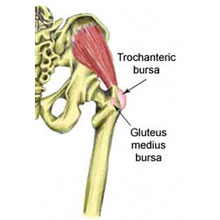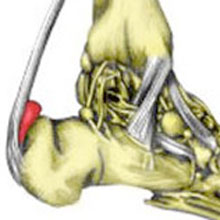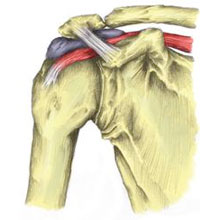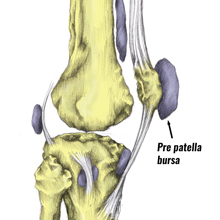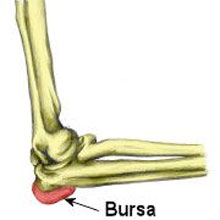Bursitis is inflammation of a small sack of fluid called a bursa. There are approximately 160 in the body, located in joints between tendon and bone. The purpose of the bursa is to aid movement of the tendon over the bone to help lubricate the joint. Here we outline the common bursitis injuries in sport.
What causes bursitis?
- Bursae (yes, this is the plural of bursa) can become inflamed from overuse, or sometimes from a direct impact or trauma. The bursa becomes inflamed, swells up, resulting in pain over the affected area.
- Bursitis is more often an overuse condition, caused by repeated rubbing of the overlying tendon.
- Injuries caused by direct impact or trauma are likely to be due to bleeding into the bursa.
Symptoms
- In cases of traumatic bursitis, a large, swollen, tender area will appear soon after impact.
- Symptoms of overuse injuries are less defined. There is usually a swollen area, although less defined than with an impact injury.
- Pain on movement-related to contracting the overlying muscle or tendon.
- The bursa will be tender to touch (if possible).
- It is sometimes difficult to distinguish between bursitis and tendon injury, without an MRI scan.
Bursitis treatment
- Impact/ traumatic injuries should be iced and a compression bandage applied.
- If the swelling doesn’t decrease naturally, the bursa may need to be aspirated (the fluid is drained using a needle).
- Overuse injuries are more difficult to treat. Rest from any aggravating activities and the use of anti-inflammatory medication is usually recommended.
- Occasionally the bursa may need to be aspirated, or corticosteroid injection may be given.
- If the bursitis is caused by any biomechanical, postural or muscular imbalances, then these should be addressed before returning to activity.
Most common bursa injuries in sport:
Hip – Trochanteric bursitis (hip)
Trochanteric bursitis is inflammation of the bursa on the outside of the hip. Symptoms include:
- Pain on the outside of the hip, which is worse when running, climbing stairs or getting in and out of a car.
- The pain will gradually get worse and the area on the outside of the hip will be tender when pressing in.
Read more on hip bursitis.
Groin – Iliopsoas bursitis
This is found between the iliopsoas muscle at the front of the hip joint and the underlying bone. Symptoms include:
- Deep pain at the front of the hip and groin.
- Pain and may radiate down to the knee or buttocks.
- You may feel a snapping sensation in the hip.
- Groin stiffness which is worse first thing in the mornings
Read more on Iliopsoas bursitis.
Thigh/buttocks – Ischial bursitis (Isciogluteal)
Ischiogluteal bursitis is inflammation of the bursa which lies between the hamstring tendon and the pelvis bone. It may become inflamed on its own, or in conjunction with hamstring tendinitis or inflammation of the tendon.
- Symptoms consist of pain at the top of your hamstrings, just under the buttocks.
Read more on Ischiogluteal bursitis.
Achilles (back of the heel)
Achilles bursitis, also known as retrocalcaneal bursitis in athletes, particularly runners. It is often be mistaken for Achilles tendonitis, or it can occur in conjunction with Achilles tendonitis. Symptoms include:
- Swelling, pain, and tenderness at the back of the heel.
Read more on Achilles bursitis.
Shoulder – Subacromial
Subacromial bursitis is inflammation of a bursa in the shoulder. Symptoms include:
- Pain in your shoulder when you lift your arm sideways and upwards in a 60-degree arc.
- The subacromial bursa is a sack of fluid over the tendon, which helps facilitate movement.
- The bursa can become trapped, especially in sports where the arm is regularly at or above shoulder level.
Read more on subacromial bursitis.
Knee – Infrapatellar
Infrapatellar bursa is inflammation of the infrapatellar bursa below the kneecap. Symptoms consist of:
- Pain at the front of the knee.
- Swelling over the area of the infrapatellar bursa.
- Pain may be similar to that of jumper’s knee or patellar tendonitis with pain just below the kneecap.
Read more on infrapatellar bursitis.
Knee – Pes Anserine
Pes anserine is inflammation a bursa on the inside of the knee. Pes anserine is the combined tendon of three muscles on the inside of the knee and inflammation of the tendon itself is likely to occur. Symptoms include pain on the lower inside of the knee, particularly when lifting the upper leg.
Read more on pes anserine bursitis.
The following are common sites of bursa injury from direct trauma or impact:
Knee – Pre-patella (housemaid’s knee)
Housemaid’s Knee also known as prepatellar bursitis or knee bursitis, is a swelling of the bursa or small sack of fluid at the front of the knee. It can be acute or sudden onset or chronic where it occurs gradually over time.
Read more on pre-patella bursitis.
Elbow – Olecranon bursitis (students elbow)
Also known as Students elbow, or Olecranon bursitis is the inflammation and swelling of the bursa which protects the end of the ulna bone at the back of the elbow.
- Repeatedly leaning on elbows (like many students do) can cause pain as the bursa becomes inflamed. Or direct impact to the back of your elbow can cause it.
Read more on Olecranon bursitis.
